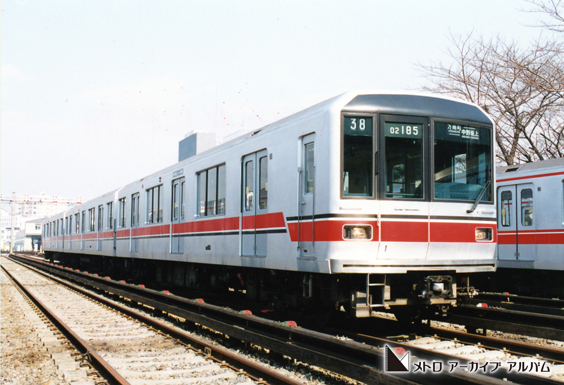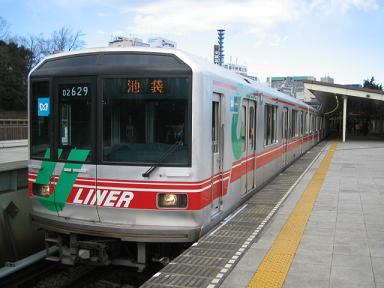Part 2
TRTA 02 series - Marunouchi Line (Early Production Set)

In the mid 1980s, the Maronouchi line was in a similar situation to the Ginza line, with it's stock dating between 1954 and 1957, thus 30 years old.
As the Marunouchi line and the Ginza line share identical technical characteristics (1435mm standard gauge, 600V DC third rail alimentation, identical loading gauge), a lightly modified and improved version of the 01 series was ordered and entered service in 1988.
Similarly to early Ginza Line sets, these were not equipped with air condtitioning until 1990-95 so they were similarly fitted with provisional air intakes.
TRTA / Tokyo Metro 02 series

The newly introduced 02 series was, again, well recieved by both passengers and crews.
The replacement of older stock (300 and 500 series stock from 1954 and 1957) took less time than on the Ginza Line, with all old trains being retired in early 1990 and with the final run of a 500 series trainset on March 1995.
In 1998, following the installation of an in-cab signalling ATC system, both the maximium speed on the line was increased from 65 to 75 Km/h and the capacity as well, wich is vital for one of the most important railway lines in Tokyo.
In 2007 the line was converted to "wanman" operation (one-man, conductor-less, driver-only operation) and in 2009 the line and the trains became ATO equipped, allowing a semi-automatic operation.
Trivia:
The Marunouchi line, the first subway line to be inaugurated after the war, was desinged to connect to as much railway stations as possible.
Running in a reversed "C" shape it connects Ikebukuro, Ochanomizu, Tokyo (the only subway line to do so), Shinjuku and Okubo.
It also stops at Otemachi (the biggest interchange of subway lines in Tokyo, with 4 lines meeting there) and Kasumigaseki, located almost below the Diet building and near the Police Headquarters, therefore making it a line used very frequently by Politicians and Government Officials.
Tokyo Metro 02 series - Refurbished trainsets
Early type without logo

later type with logo

Since it's introduction, the 02 series did a remarkably good service, but after 20 years, it still was in need of a renovation.
The first set being refurbished was 02 in 2009, and carries on as of today at the pace of 3/4 sets per year.
The refurbishment main technical modification were the DC motors and GTO Chopper control swapped out for PMSM motors and IGBT-VVVF control.
The liviery was also modified a bit, replacing the straight white line on the red band with a sine wave design identical to the stainless decoration found on 300 and 500 series sets, wich is distinctive of the Marunouchi Line.
Seats cover were also changed, from brown/red to salmon pink, again reminescent of old 300 and 500 series sets.
Intitially the refurbished trains had a plain white red band on the front, but it was later changed by adding two parallel white lines, a decorative design and the lettering"Tokyo Metro".
Trivia:
Depsite being newly refurbished, there are already plans to replace the entire 02 series fleet with the new 2000 series. The new trains will enter service by 2020 and would replace the 02 series by 2022 (but many say it will take atleast 5 years more).
TRTA - Tokyo Metro 02-80 series - Marunouchi Line, Honancho Branch

The Marunouchi Line, apart from the mainline (Ogikubo-Ikebukuro via Shinjuku-Tokyo) also has a 4-stations branch from Nakano-Sakaue to Honancho.
The line was built to access the new Maronouchi Line Nakano depot, wich is located just after Honancho Station.
Unlike the mainline, wich operates in 6-car sets, the Honancho branch line operates in 3-car sets.
The 6 sets of the 02-80 series were introduced in 1996 to replace another 6 3-car sets of the 500 series transferred from the main line.
Trivia:
There are plans to convert the Honancho branch line to 6-car operation, enabling trough services on the mainline to Ikebukuro.
TRTA - Tokyo Metro 02 series - Marunouchi Line 50th anniversary revival colors

In 2004, set 50 was repainted in an all-over red liviery idientical to the one carried by the original 300 and 500 series sets. This special liviery was later "vandalized" and trasformed into an advertisment liviery for the Ghana Choccolate company.
Trivia:
Altough the liviery lasted for barely a year, it was run both by TRTA and Tokyo Metro, following the company change in 2004.
TRTA / Tokyo Metro 02 series - "U-Liner"

Similarly to the Ginza Line, a Marunouchi Line set was transformed into a mobile advetrisment for the subway company.
Again, photos and information are very scarce.
Little notes:
TRTA (Teito* Rapid Transit Authority, also known as "Eidan") - the non-municipal Tokyo Subway operator from 1941 to 2004.
Tokyo Metro - TRTA changed company image, logo, name and a few other things in 2004, the result was what we know today as Tokyo Metro.
Toei (Tokyo Metropolitan Bureau of Transportation) - the other Tokyo Subway operator, it's a pubblic enterprise owned by the Metropolitan Government of Tokyo (TRTA/Tokyo Metro is a private national government-controlled and owned operator).
The Ginza Line was built by two different companies: Tokyo Underground Railway (Asakusa-Shimbashi) and Tokyo Rapid Railway (Ginza-Shimbashi).
During the war, they were merged by the government, forming the TRTA.
*Teito = Imperial Capital (Tokyo)
DOWNLOAD
https://drive.google.com/open?id=1QCukCv-aqE5uK3oNgYU5UtinCLp9HRrY
TRTA 02 series - Marunouchi Line (Early Production Set)

In the mid 1980s, the Maronouchi line was in a similar situation to the Ginza line, with it's stock dating between 1954 and 1957, thus 30 years old.
As the Marunouchi line and the Ginza line share identical technical characteristics (1435mm standard gauge, 600V DC third rail alimentation, identical loading gauge), a lightly modified and improved version of the 01 series was ordered and entered service in 1988.
Similarly to early Ginza Line sets, these were not equipped with air condtitioning until 1990-95 so they were similarly fitted with provisional air intakes.
TRTA / Tokyo Metro 02 series

The newly introduced 02 series was, again, well recieved by both passengers and crews.
The replacement of older stock (300 and 500 series stock from 1954 and 1957) took less time than on the Ginza Line, with all old trains being retired in early 1990 and with the final run of a 500 series trainset on March 1995.
In 1998, following the installation of an in-cab signalling ATC system, both the maximium speed on the line was increased from 65 to 75 Km/h and the capacity as well, wich is vital for one of the most important railway lines in Tokyo.
In 2007 the line was converted to "wanman" operation (one-man, conductor-less, driver-only operation) and in 2009 the line and the trains became ATO equipped, allowing a semi-automatic operation.
Trivia:
The Marunouchi line, the first subway line to be inaugurated after the war, was desinged to connect to as much railway stations as possible.
Running in a reversed "C" shape it connects Ikebukuro, Ochanomizu, Tokyo (the only subway line to do so), Shinjuku and Okubo.
It also stops at Otemachi (the biggest interchange of subway lines in Tokyo, with 4 lines meeting there) and Kasumigaseki, located almost below the Diet building and near the Police Headquarters, therefore making it a line used very frequently by Politicians and Government Officials.
Tokyo Metro 02 series - Refurbished trainsets
Early type without logo

later type with logo

Since it's introduction, the 02 series did a remarkably good service, but after 20 years, it still was in need of a renovation.
The first set being refurbished was 02 in 2009, and carries on as of today at the pace of 3/4 sets per year.
The refurbishment main technical modification were the DC motors and GTO Chopper control swapped out for PMSM motors and IGBT-VVVF control.
The liviery was also modified a bit, replacing the straight white line on the red band with a sine wave design identical to the stainless decoration found on 300 and 500 series sets, wich is distinctive of the Marunouchi Line.
Seats cover were also changed, from brown/red to salmon pink, again reminescent of old 300 and 500 series sets.
Intitially the refurbished trains had a plain white red band on the front, but it was later changed by adding two parallel white lines, a decorative design and the lettering"Tokyo Metro".
Trivia:
Depsite being newly refurbished, there are already plans to replace the entire 02 series fleet with the new 2000 series. The new trains will enter service by 2020 and would replace the 02 series by 2022 (but many say it will take atleast 5 years more).
TRTA - Tokyo Metro 02-80 series - Marunouchi Line, Honancho Branch

The Marunouchi Line, apart from the mainline (Ogikubo-Ikebukuro via Shinjuku-Tokyo) also has a 4-stations branch from Nakano-Sakaue to Honancho.
The line was built to access the new Maronouchi Line Nakano depot, wich is located just after Honancho Station.
Unlike the mainline, wich operates in 6-car sets, the Honancho branch line operates in 3-car sets.
The 6 sets of the 02-80 series were introduced in 1996 to replace another 6 3-car sets of the 500 series transferred from the main line.
Trivia:
There are plans to convert the Honancho branch line to 6-car operation, enabling trough services on the mainline to Ikebukuro.
TRTA - Tokyo Metro 02 series - Marunouchi Line 50th anniversary revival colors

In 2004, set 50 was repainted in an all-over red liviery idientical to the one carried by the original 300 and 500 series sets. This special liviery was later "vandalized" and trasformed into an advertisment liviery for the Ghana Choccolate company.
Trivia:
Altough the liviery lasted for barely a year, it was run both by TRTA and Tokyo Metro, following the company change in 2004.
TRTA / Tokyo Metro 02 series - "U-Liner"
Similarly to the Ginza Line, a Marunouchi Line set was transformed into a mobile advetrisment for the subway company.
Again, photos and information are very scarce.
Little notes:
TRTA (Teito* Rapid Transit Authority, also known as "Eidan") - the non-municipal Tokyo Subway operator from 1941 to 2004.
Tokyo Metro - TRTA changed company image, logo, name and a few other things in 2004, the result was what we know today as Tokyo Metro.
Toei (Tokyo Metropolitan Bureau of Transportation) - the other Tokyo Subway operator, it's a pubblic enterprise owned by the Metropolitan Government of Tokyo (TRTA/Tokyo Metro is a private national government-controlled and owned operator).
The Ginza Line was built by two different companies: Tokyo Underground Railway (Asakusa-Shimbashi) and Tokyo Rapid Railway (Ginza-Shimbashi).
During the war, they were merged by the government, forming the TRTA.
*Teito = Imperial Capital (Tokyo)
DOWNLOAD
https://drive.google.com/open?id=1QCukCv-aqE5uK3oNgYU5UtinCLp9HRrY
Last edited:







